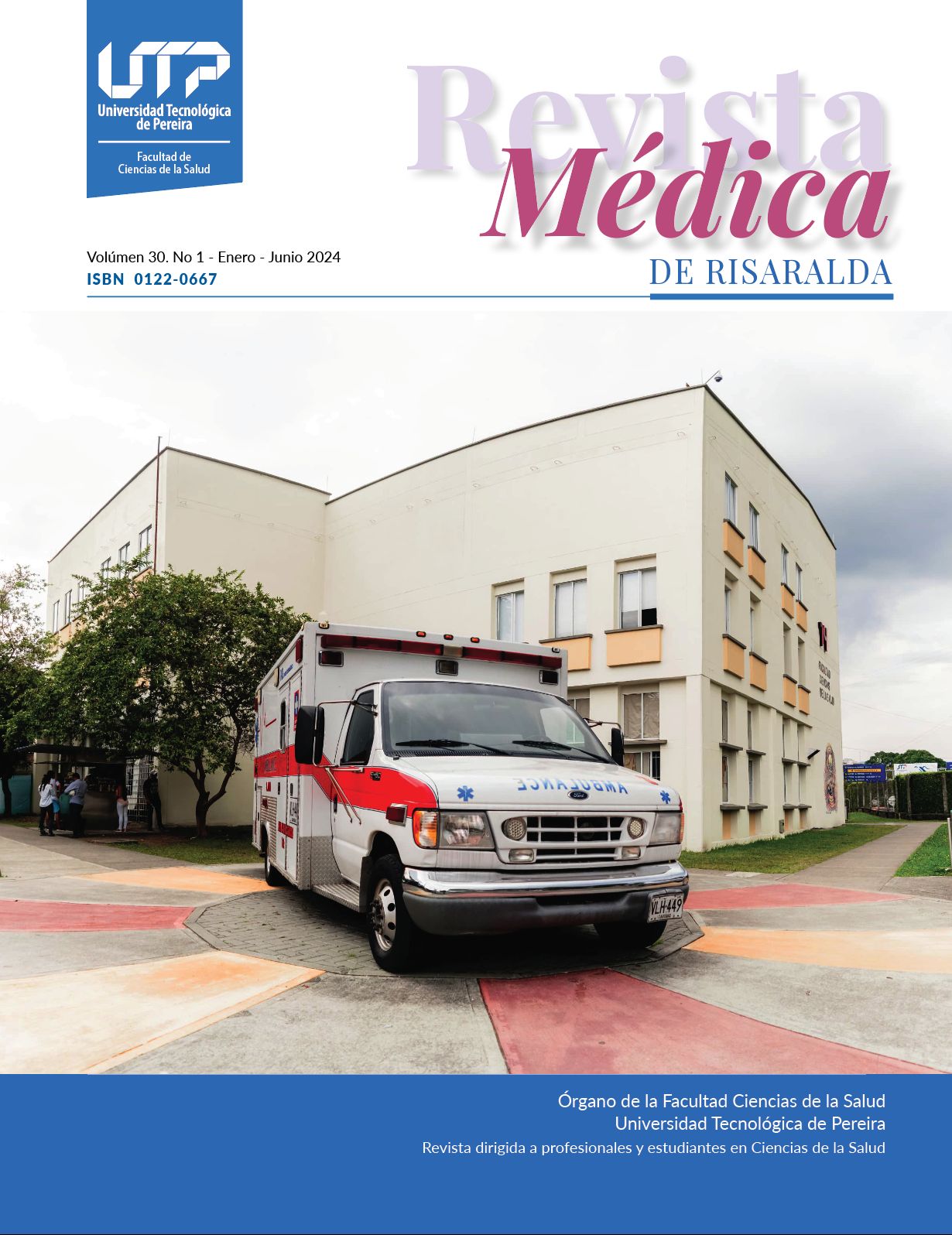Frecuencia de síntomas depresivos en pacientes con lepra de una ciudad del Caribe colombiano.
DOI:
https://doi.org/10.22517/25395203.25496Palabras clave:
depresión, lepra, enfermedad de HansenResumen
Introducción: la lepra afecta a millones de personas deteriorando la salud física y mental, generando complicaciones como síntomas depresivos que pueden afectar la calidad de vida.
Objetivo: estimar la prevalencia de síntomas depresivos en una agremiación de pacientes y expacientes con enfermedad de Hansen de una ciudad del Caribe colombiano.
Materiales y métodos: estudio descriptivo con muestreo no probabilístico en miembros de una agremiación de pacientes y ex-pacientes con enfermedad de Hansen de una ciudad del Caribe colombiano. Los síntomas depresivos fueron estimados mediante test de Beck I y los resultados se contrastaron con variables sociodemográficas y clínicas mediante análisis bivariado.
Resultados: participaron 51 personas, con una edad promedio de 52 años (IC 35,7-68,5), y predominio del sexo masculino (57%). El 39% de la población cursó bachillerato, el 25% se encontraban en tratamiento al momento de la encuesta y el 33% presentaban algún grado de discapacidad. El 27%, 16% y 2% de la población presentó depresión leve, moderada y severa respectivamente. El síntoma depresivo más frecuentemente descrito fue la fatiga (13%) seguido de cambios en el apetito (84,2%), llanto (81,6%), y tristeza (79%). No se encontró relación estadísticamente significativa entre presencia de síntomas depresivos y características sociodemográficas, el tratamiento y la discapacidad.
Conclusiones: el 35% de los encuestados con el test de Beck I obtuvo calificaciones compatibles con depresión, se recomienda incluir manejo especializado en salud mental dentro del abordaje integral del paciente y expaciente con enfermedad de Hansen.
Descargas
Citas
Barba EJR. Lepra. Enfermedad milenaria aún vigente. Rev. Mex Patol Clin Med Lab. 2021; 68 (1): 18-33.
Cáceres-Durán MA. Comportamiento epidemiológico de la lepra en varios países de América Latina, 2011-2020. Rev. Panam Salud Publica. 2022;46: e14.
Instituto Nacional de Salud-Colombia. Protocolo de Vigilancia en Salud Pública de Lepra. versión 7. [Internet] 2022 [consultado 10 de enero 2023].Disponible en: https://doi.org/10.33610/infoeventos.53s.7
Rivas-Minas AM, Chantré-Cusi A, Santa-Yepes J, Hoyos-Ocampo-DM, Pacheco R, Ferro BE. Determinación de la persistencia y diagnóstico tardío de lepra en el Valle del Cauca de 2010 a 2016. Rev. Fac. Nac. Salud Pública. 2021;39(3): e343156. doi: 10.17533/udea.rfnsp.e343156
Dadun D, Peters RMH, van Brakel WH, Bunders JGF, Irwanto I, Regeer BJ. Assessing the Impact of the Twin Track Socio-Economic Intervention on Reducing Leprosy-Related Stigma in Cirebon District, Indonesia. Int J Environ Res Public Health. 2019;16(3):349.
Barrutia Barreto Israel, Danielli Rocca Juan José, Solano Guillén Ynes Eliana. Estados depresivos en pacientes con enfermedades crónicas no transmisibles. Rev Cuban Med Gen Integr. 2022; 38(1):1-19.
American Psychiatric Association. Manual diagnóstico y estadístico de los trastornos mentales DSM-5 (5a. ed.). 2014. Editorial Médica Panamericana.
Mateus JC, Varela MT, Caicedo DM, Arias NL, Jaramillo CD, Morales LC, et al. ¿Responde la Resolución 8430 de 1993 a las necesidades actuales de la ética de la investigación en salud con seres humanos en Colombia? Biomédica. 2019; 39:448-63
Guerra Figueroa SE, Gómez Romero KY. Actualización en lepra. epidemiología, fisopatología, clasificación, diagnostico y tratatamiento. Crea Ciencia [Internet]. 1 de diciembre de 2020 [citado 25 de marzo de 2024];13(1):32-43. Disponible en: https://www.lamjol.info/index.php/CREACIENCIA/article/view/10465
Singh GP. Psychosocial aspects of Hansen's disease (leprosy). Indian Dermatol Online J. 2012 ;3(3):166-70.
Birkauser, M. Depression, menopause and estrogens, is there a correlation? Maturitas.2012; 15, (1):53-8.
Vlassoff C, Khot S, Rao S. Double jeopardy: Women and leprosy in India. World Health Stat Quart Rep 2010;49:120‐6.
Bakare AT, Yusuf AJ, Habib ZG, Obembe A. Anxiety and depression: a study of people with leprosy in Sokoto, North-Western Nigeria. J Psychiatry. 2015;s1. doi: 10.4172/2378-5756.S1-004
Bhatia MS, Chandra R, Bhattacharya SN, Imran M. Psychiatric morbidity and pattern of dysfunction in patients with leprosy. Indian J Dermatol. 2006;51:23‐5.
Eldaron AH, Kamel Z, Ahmad F. A study on divorce among Saudi female leprotic patients: An experience at Ibn Sina Hospital. Lepr Rev. 2000;64:166‐9.
Botero-Jaramillo, N, Padilla-Pinzón LT, Beltrán-Serrano MA, Ossa-Trujillo RH. Tratamiento de la enfermedad de Hansen en Colombia: medicalización y control de la enfermedad a lo largo del siglo XX. Rev. Fac. Nac. Salud Pública, 2017; 35(3): 358-368.
Botero Jaramillo, N., Polo Rivas, D., & Sinuco Rueda, L.La lepra en Colombia: estigma, identidad y resistencia en los siglos XX y XXI. Revista Salud Bosque. 2015;5(1): 67–79.
Descargas
-
Vistas(Views): 273
- PDF Descargas(Downloads): 109
- PDF (English) Descargas(Downloads): 53
Publicado
Cómo citar
Número
Sección
Licencia
Cesión de derechos y tratamiento de datos
La aceptación de un artículo para su publicación en la Revista Médica de Risaralda implica la cesión de los derechos de impresión y reproducción, por cualquier forma y medio, del autor a favor de Facultad de Ciencias de la Salud de la Universidad Tecnológica de Pereira. 1995-2018. Todos los derechos reservados ®
por parte de los autores para obtener el permiso de reproducción de sus contribuciones. La reproducción total o parcial de los trabajos aparecidos en la Revista Médica de Risaralda, debe hacerse citando la procedencia, en caso contrario, se viola los derechos reservados.
Asimismo, se entiende que los conceptos y opiniones expresados en cada trabajo son de la exclusiva responsabilidad del autor, sin responsabilizarse ni solidarizarse, necesariamente, ni la redacción, ni la editorial.
Es responsabilidad de los autores poder proporcionar a los lectores interesados copias de los datos en bruto, manuales de procedimiento, puntuaciones y, en general, material experimental relevante.
Asimismo, la Dirección de la revista garantiza el adecuado tratamiento de los datos de carácter personal



